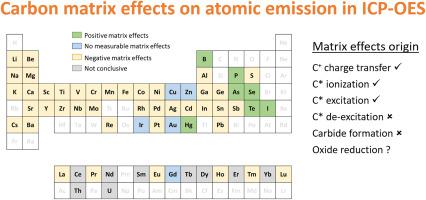Spectrochimica Acta Part B: Atomic Spectroscopy ( IF 3.2 ) Pub Date : 2021-01-17 , DOI: 10.1016/j.sab.2021.106070 Raquel Serrano , Guillermo Grindlay , Luis Gras , Juan Mora

|
In inductively coupled plasma optical emission spectrometry (ICP-OES), the presence of carbon in the matrix strongly affects (positively and negatively) the emission signal of atomic lines. However, the emission signal of ionic lines is mostly unaffected by this concomitant. The goal of this work is to gain insight into the origin of carbon matrix effects on the signal of atomic lines in ICP-OES. To this end, the emission signal of a total of 3608 lines (i.e., 1755 atomic and 1853 ionic lines) of 62 elements (Ag, Al, As, Au, B, Ba, Be, Ca, Cd, Ce, Co, Cr, Cs, Cu, Dy, Er, Eu, Fe, Ga, Gd, Ge, Hg, Ho, I, In, Ir, K, La, Li, Lu, Mg, Mn, Mo, Na, Nb, Nd, Ni, P, Pb, Pd, Pr, Pt, Re, Rh, S, Sb, Sc, Se, Sm, Sn, Sr, Tb, Te, Th, Ti, Tm, U, V, Y, Yb, Zn and Zr) were registered for carbon containing solutions (20 g L−1) prepared from glycerol. Results were compared to those obtained operating a 1% w w−1 HNO3 solution. Compared to the HNO3 reference solution, emission signals for As, B, Hg, I, P, Se and Te atomic lines were increased for the carbon containing solution. However, signal suppression was noticed for the signal emission of Ag, Al, Ba, Be, Ca, Cd, Co, Cr, Cs, Eu, Fe, Ga, Ge, K, Ho, In, La, Li, Lu, Mg, Mn, Mo, Na, Nb, Ni, Pb, Pd, Pr, Pt, Re, Rh, S, Sb, Sc, Sn, Sr, Ti, Tm, V, Y and Zr atomic lines. No measurable matrix effects within experimental uncertainties were registered for Au, Cu, Ir, Gd and Zn atomic lines. As regards Ce, Dy, Er, Nd, Sm, Tb, Th, U and Yb no clear conclusion about matrix effects was feasible due to the limited atomic emission wavelengths monitored. Experimental results showed that the intensity of matrix effects depends on both analyte ionization energy and the energy of the electronic upper level involved in the electronic transition. Matrix effects on atomic emission lines can be explained by the simultaneous occurrence of different mechanisms: (i) charge transfer reactions; (ii) collisional ionization; and (iii) collisional excitation with carbon-based species. Because these mechanisms mostly affect analyte atomic population, carbon matrix effects are more significant on the emission signal of atomic lines rather than ionic ones. Finally, the judicious analyte wavelength selection is critical to minimize carbon matrix effects for those elements for which the most sensitive wavelength is atomic (i.e., Se and alkali elements). On this regard, the selection of the internal standard should consider both the ionization energy and the energy of the electronic upper level of the analyte.
中文翻译:

洞察碳基质对电感耦合等离子体发射光谱中原子线发射信号的影响
在电感耦合等离子体发射光谱法(ICP-OES)中,基质中碳的存在会强烈(正向和负向)影响原子线的发射信号。但是,离子线的发射信号几乎不受此伴随的影响。这项工作的目的是深入了解碳基质对ICP-OES中原子线信号的影响。为此,总共3608行(即1755原子和1853离子行)的发射信号包含62种元素(Ag,Al,As,Au,B,Ba,Be,Ca,Cd,Ce,Co,Cr ,Cs,Cu,Dy,Er,Eu,Fe,Ga,Gd,Ge,Hg,Ho,I,In,Ir,K,La,Li,Lu,Mg,Mn,Mo,Na,Nb,Nd,Ni ,P,Pb,Pd,Pr,Pt,Re,Rh,S,Sb,Sc,Se,Sm,Sn,Sr,Tb,Te,Th,Ti,Tm,U,V,Y,Yb,Zn和Zr )登记用于含碳溶液(20 g L -1)由甘油制备。将结果与使用1%ww -1 HNO 3溶液获得的结果进行比较。与HNO 3相比参考溶液中,含碳溶液中As,B,Hg,I,P,Se和Te原子线的发射信号增加。但是,发现Ag,Al,Ba,Be,Ca,Cd,Co,Cr,Cs,Eu,Fe,Ga,Ge,K,Ho,In,La,Li,Lu,Mg的信号发射均受到信号抑制,Mn,Mo,Na,Nb,Ni,Pb,Pd,Pr,Pt,Re,Rh,S,Sb,Sc,Sn,Sr,Ti,Tm,V,Y和Zr原子线 在实验不确定性范围内,没有针对Au,Cu,Ir,Gd和Zn原子线记录可测量的基体效应。关于Ce,Dy,Er,Nd,Sm,Tb,Th,U和Yb,由于所监测的原子发射波长有限,因此没有明确的关于基质效应的结论是可行的。实验结果表明,基质效应的强度既取决于分析物的电离能,又取决于参与电子跃迁的电子上位能。原子发射谱线上的基体效应可以通过同时发生不同的机理来解释:(i)电荷转移反应;(ii)碰撞电离;(iii)与碳基物质的碰撞激发。由于这些机制主要影响分析物的原子数量,因此碳基体效应对原子线的发射信号的影响要强于离子线的发射信号。最后,明智的分析物波长选择对于最小化最敏感波长是原子的那些元素(即硒和碱元素)的碳基质效应至关重要。在这方面,内标的选择应同时考虑电离能和分析物电子上位能。











































 京公网安备 11010802027423号
京公网安备 11010802027423号